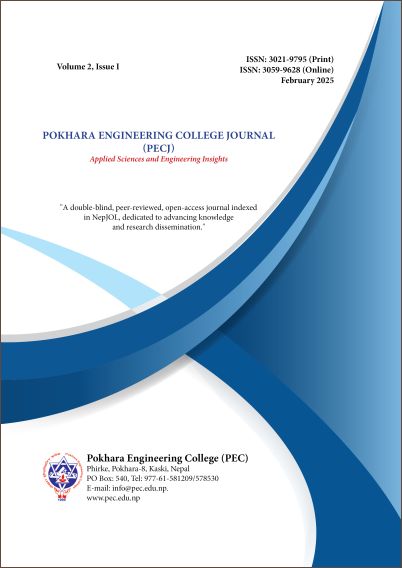Compliance Status of Nepal National Building Code (NBC: 105) within Pokhara Metropolitan City
DOI:
https://doi.org/10.3126/pecj.v2i1.76829Keywords:
Building code compliance, NBC 105, seismic resilience, urban developmentAbstract
Earthquake-induced structural failures globally emphasize the critical need for stringent building code compliance, particularly in seismically active regions like Nepal. This research evaluates the compliance status of Nepal National Building Code (NBC 105) in Pokhara Metropolitan City (PMC), following its 2022 revision post-Gorkha Earthquake (2015). Being Nepal's second-largest urban center with seismic zoning factor (Z) of 0.3 which is moderate in context of Nepal and have not experienced any major earthquake in recent decades, the study was necessary in the project area. The study aims to assess compliance during design and construction phases, identify barriers, and propose actionable solutions. A mixed-methods approach encompassing desk reviews, field surveys, and key informant interviews with 45 stakeholders was employed over nine months. Results revealed a meager 2.63% compliance during the design phase. These deficiencies compromise the seismic resilience of the 100,000+ buildings already constructed in PMC, raising significant safety concerns. The findings highlight that limited stakeholder awareness, insufficient technical training, economic constraints, and weak enforcement mechanisms are the primary barriers to adherence. Key recommendations include simplifying NBC provisions to enhance cost-effectiveness, implementing targeted capacity-building programs for engineers and contractors, and conducting public awareness campaigns to promote seismic safety. Additionally, retrofitting non-compliant structures and leveraging technology, such as Building Information Modeling (BIM) and remote sensing, for construction monitoring are vital steps forward. This study underscores the need for robust policy enforcement and strategic interventions to ensure seismic resilience in Nepal's urban development. By aligning safety with economic feasibility, these insights contribute to a sustainable and earthquake-resilient future.
Downloads
Downloads
Published
How to Cite
Issue
Section
License
Copyright (c) 2025 Pokhara Engineering College

This work is licensed under a Creative Commons Attribution-NonCommercial 4.0 International License.
This license enables reusers to distribute, remix, adapt, and build upon the material in any medium or format for noncommercial purposes only, and only so long as attribution is given to the creator.




